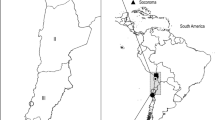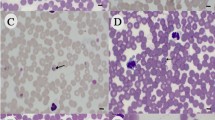Abstract
Anaplasmosis and ehrlichiosis are of serious health concern worldwide for animals and humans. In the present study, we report the occurrence of Anaplasma platys and Ehrlichia canis in dogs and Rhipicephalus sanguineus sensu lato (s.l.) ticks from Peninsular Malaysia using a nested polymerase chain reaction assay based on amplification of the 16S rRNA gene. Anaplasma platys was detected from dogs and ticks with prevalence rates of 3.3% (8/240) and 2.9% (4/140), respectively. On the other hand, 12.9% (31/240) of the dogs and 0.7% (1/140) of the ticks were tested positive for E. canis. Additionally, co-infections of A. platys and E. canis with Babesia or Hepatozoon protozoa were also noted in this study. Double infection (E. canis + B. gibsoni) was observed in tick, whereas triple infections (E. canis + A. platys + B. vogeli and E. canis + A. platys + H. canis) were found in dogs. This study represents the first evidence of A. platys DNA in R. sanguineus s.l. in Malaysia.
Similar content being viewed by others
References
Alho AM, Lima C, Latrofa MS, Colella V, Ravagnan S, Capelli G, de Carvalho LM, Cardoso L, Otranto D (2017) Molecular detection of vector-borne pathogens in dogs and cats from Qatar. Parasit Vectors 10:298
Anastos G (1950) Genus Rhipicephalus sanguineus C.L. Koch, 1844. The scutate ticks or Ixodidae of Indonesia. Entomol Am 30:1–144
Anderson BE, Sumner JW, Dawson JE, Tzianabos T, Greene CR, Olson JG, Fishbein DB, Olsen-Rasmussen M, Holloway BP, George EH, Azad AF (1992) Detection of the etiologic agent of human ehrlichiosis by polymerase chain reaction. J Clin Microbiol 30:775–780
Barker SC, Walker AR (2014) Ticks of Australia. Reprod Domest Anim 3816:1–144
Beall MJ, Alleman AR, Breitschwerdt EB, Cohn LA, Couto CG, Dryden MW, Guptill LC, Iazbik C, Kania SA, Lathan P, Little SE, Roy A, Sayler KA, Stillman BA, Welles EG, Wolfson W, Yabsley MJ (2012) Seroprevalence of Ehrlichia canis, Ehrlichia chaffeensis and Ehrlichia ewingii in dogs in North America. Parasit Vectors 5:29
Brites-Neto J, Duarte KMR, Martins TF (2015) Tick-borne infections in human and animal population worldwide. Vet World 8:301–315
Cardoso L, Oliveira AC, Sara Granada, Nachum-Biala Y, Gilad M, Lopes AP, Sousa SR, Vilhena H, Baneth G (2016) Molecular investigation of tick-borne pathogens in dogs from Luanda. Angola. Parasit Vectors 9:252
Dawson JE, Biggie KL, Warner CK, Cookson K, Jenkens S, Levine JE, Olson JG (1996) Polymerase chain reaction evidence of Ehrlichia chaffeensis, an etiologic agent of human ehrlichiosis, in dogs from southeast Virginia. Am J Vet Res 57:1175–1179
Diniz PP, Beall MJ, Omark K, Chandrashekar R, Daniluk DA, Cyr KE, Koterski JF, Robbins RG, Lalo PG, Hegarty BC, Breitschwerdt EB (2010) High prevalence of tick-borne pathogens in dogs from an Indian reservation in northeastern Arizona. Vector Borne Zoonotic Dis 10:117–123
Gaunt SD, Beall MJ, Stillman BA, Lorentzen L, Diniz PPVP, Chandrasheker R, Breitschwerdt EB (2010) Experimental infection and co-infection of dogs with Anaplasma platys and Ehrlichia canis: hematologic, serologic and molecular findings. Parasit Vectors 3:33
Goncalves LR, Filgueira KD, Ahid SMM, Pereira JS, do Vale AM, Machado RZ, Andre MR (2014) Study on coinfecting vector-borne pathogens in dogs and ticks in Rio Grande do Norte, Brazil. Braz J Vet Parasitol 23:407–412
Ismail N, Bloch KC, McBride JW (2010) Human ehrlichiosis and anaplasmosis. Clin Lab Med 30:261–292
Koh FX, Panchadcharam C, Tay ST (2016) Vector-borne diseases in stray dogs in Peninsular Malaysia and molecular detection of Anaplasma and Ehrlichia spp. from Rhipicephalus sanguineus (Acari: Ixodidae) ticks. J Med Entomol 53:183–187
Konto M, Tukur SM, Watanabe M, Abd-Rani PAM, Sharma RSK, Fong LS, Watanabe M (2017) Molecular and serological prevalence of Anaplasma and Ehrlichia sp. among stray dogs in East Malaysia. Trop Biomed 34:570–575
Kordick SK, Breitschwerdt EB, Hegarty BC, Southwick KL, Colitz CM, Hancock SI, Bradley JM, Rumbough R, Mcpherson JT, MacCormack JN (1999) Coinfection with multiple tick-borne pathogens in a Walker Hound kennel in North Carolina. J Clin Microbiol 37:2631–2638
Lasta CS, dos Santos AP, Messick JB, Oliveira ST, Biondo AW, Vieira RF, Dalmolin ML, Gonzalez FH (2013) Molecular detection of Ehrlichia canis and Anaplasma platys in dogs in Southern Brazil. Rev Bras Parasitol Vet 22:360–366
Lauzi S, Maia JP, Epis S, Marcos R, Pereira C, Luzzago C, Santos M, Puente-Payo P, Giordana A, Pajoro M, Sironi G, Faustino A (2016) Molecular detection of Anaplasma platys, Ehrlichia canis, Hepatozooon canis and Rickettsia monacensis in dogs from Maio Island of Cape Verde archipelago. Ticks Tick-borne Dis 7:964–969
Licari E, Takacs N, Solymosi N, Farkas R (2017) First detection of tick-borne pathogens of dogs from Malta. Ticks Tick Borne Dis 88:396–399
Little SE, Stallknecht DE, Lockhart JM, Dawson JE, Davidson WR (1998) Natural coinfection of a white-tailed deer (Odocoileus virginianus) population with three Ehrlichia spp. J Parasitol 84:897–901
Mohammed K, Tukur SM, Watanabe M, Rani PAMA, Sharma RSK, Fong LS, Watanabe M (2017) Molecular and serological detection of tick-borne hemopathogens among stray dogs in East Malaysia. J Vet Med Res 4:1074
Mokhtar AS, Lim SF, Tay ST (2013) Molecular detection of Anaplasma platys and Babesia gibsoni in dogs in Malaysia. Trop Biomed 30:345–348
Moraes-Filho J, Krawczak FS, Costa FB, Soares JF, Labruna MB (2015) Comparative evaluation of the vector competence of four South American populations of the Rhipicephalus sanguineus group for the bacterium Ehrlichia canis, the agent of canine monocytic ehrlichiosis. PLoS ONE 10:e0139386
Moutailler S, Moro CV, Vaumourin E, Michelet L, Tran FH, Devillers E, Cosson J-F, Gasqui P, Van VT, Mavingui P, Vourc’h G, Vayssier-Taussat M (2016) Co-infection of ticks: the rule rather than the exception. PLoS Negl Trop Dis 10:e0004539
Nazari M, Lim SY, Watanabe M, Sharma RSK, Cheng NABY, Watanabe M (2013) Molecular detection of Ehrlichia canis in Malaysia. PLoS Negl Trop Dis 7:e1982
Otranto D, Testini G, Dantas-Torres F, Latrofa MS, Diniz PP, de Caprariis D, Lia RP, Mencke N, Stanneck D, Capelli G, Breitschwerdt EB (2010) Diagnosis of canine vector-borne diseases in young dogs: a longitudinal study. J Clin Microbiol 48:3316–3324
Prakash BK, Low VL, Tan TK, Vinnie-Siow WY, Lim YAL, Movarid AR, Azman AS, Yeong YS, Abubakar S, Sofian-Azirun (2018a) Detection of Hepatozoon canis in the brown dog tick and domestic dogs in Peninsular Malaysia. J Med Entomol. https://doi.org/10.1093/jme/tjy081
Prakash BK, Low VL, Vinnie-Siow WY, Tan TK, Lim YAL, Movarid AR, AbuBakar S, Sofian-Azirun M (2018b) Detection of Babesia spp. in dogs and their ticks from Peninsular Malaysia: emphasis on Babesia gibsoni and Babesia vogeli infections in Rhipicephalus sanguineus sensu lato (Acari: Ixodidae). J Med Entomol. https://doi.org/10.1093/jme/tjy072
Rotondano TE, Almeida HK, da Silva Krawczak F, Santana VL, Vidal IF, Labruna MB, de Azevedo SS, de Almeida AMP, de Melo MA (2015) Survey of Ehrlichia canis, Babesia spp. and Hepatozoon spp. in dogs from a semiarid region of Brazil. Braz J Vet Parasitol 24:52–58
Sainz A, Roura X, Miro G, Estrada-Pena A, Kohn B, Harrus S, Solano-Gallego L (2015) Guideline for veterinary practitioners on canine ehrlichiosis and anaplasmosis in Europe. Parasit Vectors 8:75
Silveira JA, Valente PC, Paes PR, Vasconcelos AV, Silvestre BT, Ribeiro MF (2015) The first clinical and laboratory evidence of co-infection by Anaplasma phagocytophilum and Ehrlichia canis in a Brazilian dog. Ticks Tick Borne Dis 6:242–245
Simpson RM, Gaunt SD, Hair JA, Kocan KM, Henk WG, Casey HW (1991) Evaluation of Rhipicephalus sanguineus as a potential biological vector of Ehrlichia platys. Am J Vet Res 52:1537–1541
Skotarczak B (2003) Canine ehrlichiosis. Ann Agric Environ Med 10:137–141
Tamura K, Stecher G, Peterson D, Filipski A, Kumar S (2013) MEGA 6: molecular evolutionary genetic analysis version 6.0. Mol Biol Evol 30:2725–2729
Acknowledgements
This study was financially supported by the University of Malaya Research Grants (BK097-2016, RU005-2017, and PG098-2016A).
Author information
Authors and Affiliations
Corresponding author
Rights and permissions
About this article
Cite this article
Low, V.L., Prakash, B.K., Lim, Y.AL. et al. Detection of Anaplasmataceae agents and co-infection with other tick-borne protozoa in dogs and Rhipicephalus sanguineus sensu lato ticks. Exp Appl Acarol 75, 429–435 (2018). https://doi.org/10.1007/s10493-018-0280-9
Received:
Accepted:
Published:
Issue Date:
DOI: https://doi.org/10.1007/s10493-018-0280-9




